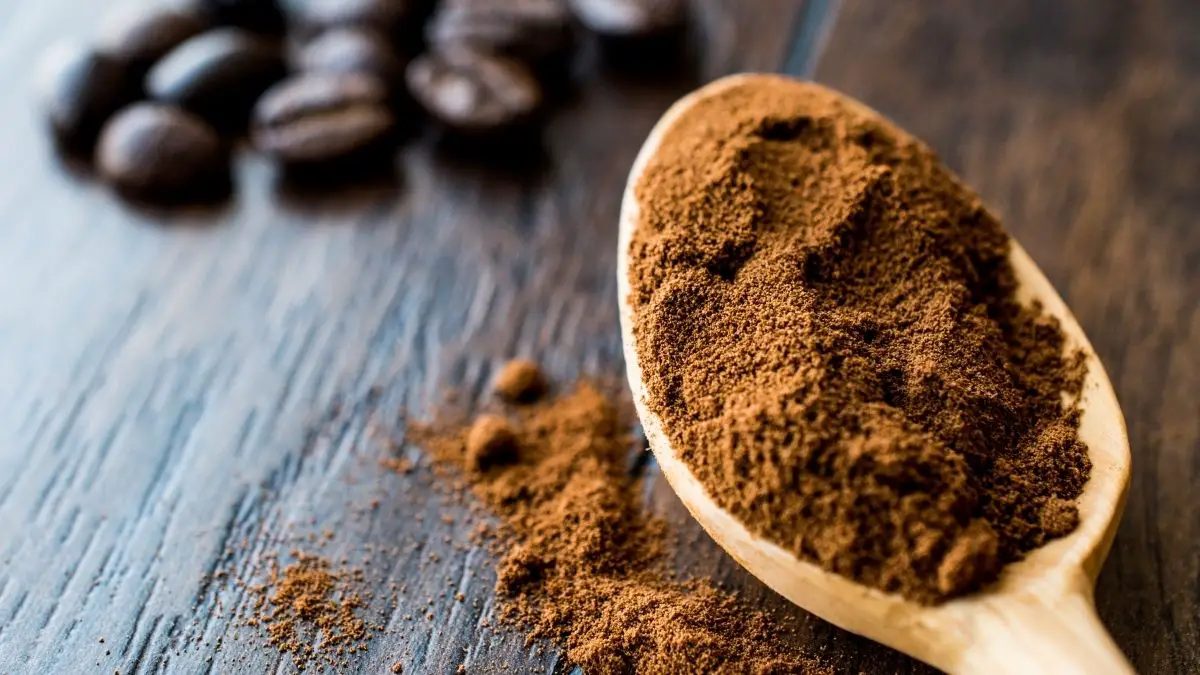No. Espresso powder and ground coffee are two different things. And they’re not interchangeable either. You can’t drink a cup of espresso powder. And you can’t use ground coffee for baking.
Espresso powder is only used for baking, especially in making chocolate-flavored pastries. It dissolves into food easily, which makes it ideal for cooking. Ground coffee is what you drink in your cup of joe. It’s made through different brewing methods that are widely used throughout the world.
Whether or not you have just started your coffee adventure, it’s worth learning more about what you drink, and how it differs from a baking or cooking ingredient.
Espresso Powder
Also known as instant espresso, an espresso powder is made out of previously brewed ground espresso beans, dried, and then grind further into a finer powder. This makes it easier to use in cooking and baking as it dissolves faster.
An espresso powder is commonly used to complement the flavor of your dish, especially when baking chocolate-flavored cakes, brownies, and more. Since it’s been dried and ground even further, using it to make your coffee drink will no longer contribute to the taste of a real espresso.
Can You Make Your Own Espresso Powder?
Yes, you definitely can. Assuming that you have your own espresso machine with a built-in grinder, a coffee grinder, or both at home, making your own espresso powder is easy and rather cheap. You may also use a blender, a mortar and pestle, or a food processor to make espresso powder.
Finding one is difficult and that’s why many bakers would just make their own espresso powder. Thus, it’s not possible for you either. Let’s check what you need to make one at home.
What you’ll need:
- Used ground espresso or coffee beans
- Foil baking sheet
What to do:
- Preheat your oven to 170°F and line the baking sheet.
- Spread the leftover ground espresso beans on the foil baking sheet.
- Bake the ground espresso for at least two or three hours until it’s dry and a little crunchy.
- Put them into the coffee grinder and grind them into a finer powder.
- Place the espresso powder in an airtight container for future use. Just keep it in a cool and dry place to ensure that it lasts for a year or more as long as it still gives you the aroma.
How To Use Espresso Powder
Espresso powder is very useful for cooking and baking. It gives the dish a richer and bolder taste, especially in baked goodies that need a chocolate flavor enhancer.
But it’s just for chocolate-flavored goodies. There are a few ways to use it that will amplify the taste.
- Ice Cream Sprinkle. If you’re an ice cream fan, especially chocolate or vanilla flavor, you can sprinkle a bit of espresso powder on top. It will give the ice cream a richer taste.
- Chocolate Sauce and Frosting Booster. Add some espresso powder to your chocolate frosting, hot fudge, or chocolate ganache to boost the flavor.
- Chili Enhancer. For a vegan or vegetarian pot of chili, a little addition of espresso powder can help make the flavor reach its depths. Its texture makes the chili more complex and bolder.
- Spices and Herb Mix. You can treat espresso powder as a spice in your kitchen alongside other spices like smoked paprika, chili powder, rosemary, basil, cilantro, and more. This can add a spell on the umami flavoring of barbecues, steaks, and meat dishes.
- Chocolate Pastries Enhancer. If you love baking, espresso powder is a must-have. Your chocolate cakes, cupcakes, brownies, cookies, and more will be tastier and richer when you add at least a teaspoon of espresso powder.
Ground Coffee
So, here’s where your favorite cuppa comes from. Ground coffee is a staple to most coffee shops. In a nutshell, brewed coffee is made of ground coffee.
After the cherries or coffee beans from the coffee plant are roasted, they’re ground or milled into smaller pieces using a coffee grinder, food processor, blender, or even mortar and pestle. This produces the ground coffee that you usually drink from a cup.
Ground coffee cannot be used in cooking or baking as it doesn’t dissolve the way espresso powder can. It also gives a different taste to your dish due to its texture. So, the general rule of thumb is that ground coffee can’t be used in cooking, and espresso powder isn’t for drinking.
There are different results ground coffee can produce. They depend on how long you grind the coffee beans.
- Coarse Coffee Grounds. The particles are chunky like the size of kosher salt.
- Medium Grounds. These are like the size of gritty, coarse sand.
- Fine Grounds. They’re smooth and like the size of sugar or table salt.
- Extra Fine. These particles are smaller than sugar or salt.
- Turkish Grounds. These are powdered coffee grounds like flour.
If grinding your whole coffee beans isn’t accessible to you, it’s helpful to just buy them at your local grocer or supermarkets, and even on Amazon. There are many quality ground coffee brands that you can have. If you need help with choosing the best ones, here’s what we can recommend.
- Death Wish Coffee Co. Dark Roast
- Kicking Horse Coffee Smart Ass Blend Medium Roast
- Starbucks Veranda Blend Light Roast
- Mount Hagen Instant Coffee
- No Fun Jo Decaf Ground Coffee
- La Colombe Corsica Dark Roast
- Seattle’s Best Coffee House Blend
- New England Coffee
- Stone Street Coffee Cold Brew Reserve
- Illy Classico Espresso
- 365 by Whole Foods Market Organic Coffee Vienna Roast Pacific Rim
- Peet’s Coffee Single Origin Brazil Medium Roast
How To Use Ground Coffee Leftovers
What’s more interesting about ground coffee is that you can also use it on other things apart from drinking it. Well, at least when you have leftovers, don’t discard them right away.
Yes, you heard it right. Ground coffee has other creative things to do aside from giving you your favorite cup of joe. And that’s very useful, especially at home.
Check out how you can get creative with your ground coffee leftovers. Don’t worry. If you get hooked to it and you don’t have enough at home, visit your local coffee shops. They’d be more than glad to give you their leftovers.
- Garden Fertilizer. Coffee contains minerals that help plant growth, and just because they’re leftovers doesn’t mean they lose their nutrients. Sprinkle the grounds on the soil where your plants at.
- Compost. When you compost the ground coffee, it helps lower the greenhouse gas emissions and increase your plants’ nutrient levels.
- Insects and Pests Repellent. Coffee contains high levels of caffeine and diterpenes. These are chemical compounds that are fatal to insects such as bugs, mosquitos, fruit flies, and more. Simply sprinkle or scatter the ground coffee around your garden.
- Pet Fleas Remover. If you’re a fur parent, you know how it feels for your pets when they’re attacked by fleas. To help keep fleas at bay, simply rub the ground coffee on their fur after shampooing.
- Odor Neutralizer. Refrigerators, cars, drawers, shoes, gym bags, among others can create foul smells when air sulfur gas is combined with carbon. Coffee contains nitrogen that helps neutralize bad odor. Simply put the ground anywhere that needs deodorizing.
- Skin Exfoliator. The coarse texture of ground coffee helps exfoliate your skin. Simply mix it with coconut oil or honey.
- Hair Growth Stimulator. Caffeine helps hair growth and any buildups in the scalp. Simply massage ground coffee into your scalp before shampooing. Do this at least twice a week.
- Natural Dye. Caffeine leaves stains on anywhere you spill it, especially when they’re not treated right away. So, if you need to darken your hair, or dye fabric, paper, cellophane, and more, simply wet the Ground Coffee and apply. Also, coffee is non-toxic and a natural dye. You’re safe.
- Mushroom Grower. Mushrooms don’t just grow everywhere. They’re very picky, but they like the nutrients found in coffee grounds. If you grow mushrooms at home, especially shiitake and oyster, consider Ground Coffee your hero!
- Under-Eye Circles Treatment. There are many reasons why we always get under-eye circles. Aging, stress, poor skin rejuvenation, lack of sleep, among others are the culprit. According to a study, caffeine helps stimulate blood circulation around the eyes. And of course, we think about coffee, which is high in caffeine and antioxidants. Simply make a paste with water or coconut oil and apply it under your eyes. Leave it there for 10 minutes and rinse. You can do it daily.
The Bottom Line
Espresso powder and ground coffee are different and not interchangeable. The former is only used for cooking or baking while the latter is for drinking and other creative uses at home and even as a skincare product.
If you want to know more about espresso-based drinks, we have a comprehensive list here to guide you on your coffee adventure!

